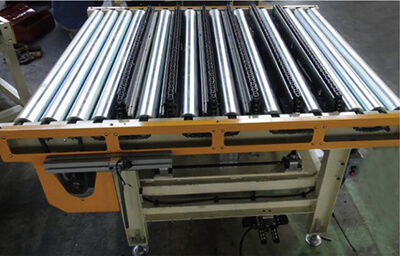HUZHOU EARN DOLLAR INTELLGENT EQUIPMENT CO., LTD.
The roller conveyor is a device or structure that uses the rollers forming a regular surface to facilitate the handling and movement of a wide variety of objects, such as boxes, pallets, packages.
Unlike other older conveyor systems, a roller transfer conveyor design comes as a modular system that allows the combination of segments with free-spinning rollers for manual merchandise operating points, gravity-actuated roller segments, and roller segments motorized.

The basic principle of its operation consists of moving the load on the rollers that rotate on their own fixed axis to the structure.
Advantages of using the roller conveyor
Undoubtedly, the main advantage of using a roller conveyor is the extra space that makes it easier for us to accumulate objects. The arrangement of the conveyor rollers in single file will allow objects to move through them without being fully braked, thus avoiding creating a plug. For this reason it is used in multiple industrial processes and warehouses.
Roller conveyor applications
The main use of roller conveyors is to move goods from one part to another within the warehouse, thus avoiding user intervention, saving time and optimizing productivity. There are warehouses that look like real roller conveyor highways due to the large number of orders, or movement at the end of the packaging line. Specifically in the packaging industry, the sealers and box formers usually have as an accessory the sections or roller conveyor, since when the boxes leave the sealers, they need a support space to be able to accumulate them and that they do not fall just apply the seal on them. To summarize, the 3 main uses of roller conveyors are:
· Transfer sections between conveyor belts
· For storage or accumulation of empty or full boxes
· To transfer empty containers to workstations or full containers to the Dispatch Area
Main components of roller conveyors
The conveyor rollers must support all types of loads, from light to heavy, since they will perform the function of storing or transporting from bottles to pallets, steel containers, etc.
Structure
For the design of the structure of the roller conveyor, we must take into account the loads and working capacities. The structure is built with hot-formed profiles, with C, I or T section beams, made of galvanized steel or aluminum.
Conveyor rollers
The main materials of which the tubes of the conveyor rollers are composed are: PVC, stainless steel, zinc plated steel and aluminum.
However, when choosing your transfer conveyor suppliers, you need to consider some essential factors. The first is the quality of the rollers. The quality of the transfer rollers determines its durability and its efficiency in supporting your industrial needs.
The width of the roller is also important and will depend on the size of the loads. Price is another factor but you don’t have to compromise quality for price. This is why it is important to liaise with a reputable supplier.
Conclusions
The use of the roller conveyor has increased significantly in recent years in proportion to the rise of electronic commerce, as warehouses have been forced to face a higher frequency of orders of all kinds. Therefore this simple-looking structure, is becoming very important over the years and every time.